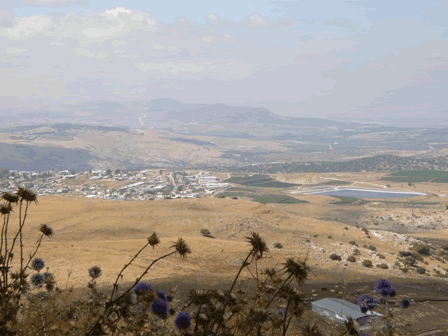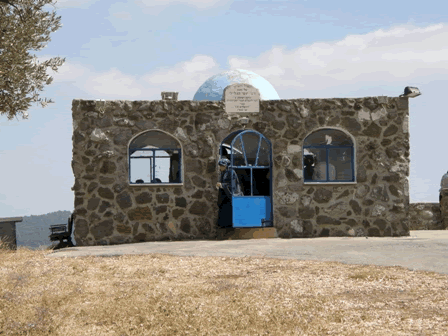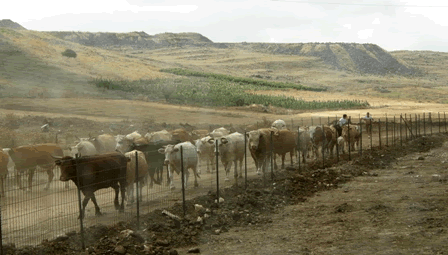|
Rabbi Yose from the Galil - A Wise Man with a Generous Heart
By Vardah Littmann
The Galilee is is always so beautiful no matter what the season of the year, a balm for the eyes and the soul. The rich history of our people in the Land of Israel can be seen and felt so clearly on the pastoral hilltops and in the rustic valleys of the area. As on travels about in the area traversing the rolling roadway one encounters the final resting places of so many of our great learned men of times gone by, men of such immense stature that their slightest wish was fulfilled by the Master of the World.
The settlement of Dalton which is near Tzfat was founded in 1950 by immigrants from Tripoli, Libya. Dalton is mentioned in medieval literature and in documents discovered in the Cairo Geniza. In the Geniza there is a portion of a letter sent from Dalton to Egypt signed by "Shlomo HaKohen son of Yosef from the city of Dalton." There is also a document regarding the wise man, Eliyahu HaKohen, who died in Tyre in 1063 stating that his body was carried on many people's shoulders to a mountain in the Galilee, called Dalton for burial.

View Of Dalton from Tomb of Rabbi Yose HaGalili
On the settlement there is a winery selling fine delectable wines, made from the abundant flourishing grapes grown on the grounds. There is also a hostel for vacationers on Dalton.
High in the hills of Dalton, surrounded in breathtaking scenery, is the Tomb of Rabbi Yose HaGalili (Yose the Galilean). Just as Choni HaMa'agel was known for his piety in his ability to make the rain fall, so too was Rabbi Yose HaGalili famed, for his righteousness in the same matter. An Amora (rabbi of the Talmud) of the third century says: "When the sins of the nation of Israel cause drought and a person such as Yose the Galilean prays for rain, the rain start to fall immediately" (Jerusalem Talmud, Berachos 9b).
During his lifetime Yose the Galilean was known as a healer of barren women. After his death, it is reported barren women used make pilgrimages to his Rabbi, they would tie pieces of cloth to the trees around it as a amulet to be blessed with offspring.

Tomb of Rabbi Yose HaGalili
Rabbi Yose the Galilean was a third generation Tanna (scholar of the Mishna), who lived at the beginning of the second century of the common era. He was one of the pupils of Kerem b'Yavne. Rabbi Akiba and Rabbi Tarphon (the wealthy Cohen) were of his teachers. He was a contemporary of Rabbi Eliezer, Rabbi Eleazar ben Azariah and Rabbi Meir. He lived at the time of the Bar Kokhba revolt.
We find Rabbi Yose the Galilean opinions dispersed though the Talmud and Mishnah. We even meet up with him in the Hagada of the awesome night of the Seder. ' Rabbi Yose the Galilean says...' Here he expounds a 1:5 ratio for the plagues in Egypt to those on the Reed Sea. He shows that the ten plagues were caused by one 'finger' of G-d , bringing proof from the fact that the Egyptians said the ten plagues were a finger of G-d . Therefore if the 'hand' of G-d was seen by the nation being manifested at the sea, the conclusion is that the Egyptians suffered fifty plagues by the sea.
In the Talmud we again find Rabbi Yose HaGalili expounding on Spliting of the Sea of Reeds. He gives a description of how the Jewish people sang the Song of the Sea, elucidating how entire nation broke into spontaneous singing together in unison.
The Books 'Midrash Says' and 'Ma Am Loaz' ask... How can it be explained that they managed to sing as one? It was due to the fact that the nation experienced an actual perception of the G-d, with such a clarity of prophetic vision and inspiration they sang the song as if they had rehearsed it together for many years. Once the prophetic flux began to flow all the nation young and old, maid servants, infants suckling at their mothers' breast and embryos in their mothers wombs were able to sing "This is my G-d and I will glorify Him, my father's G-d and I will exalt Him".
One day as Rabbi Yose HaGalili was walking along the road and he met the wife of Rabbi Meir, Beruriah. He asked her "Which way does one get to Lod?" She rebuked him "Foolish Galilean, did not the sages say 'Do not gossip with women'? You should have asked in a shorter way saying 'which is to Lod'?" (Eiruvin 53b)
Rabbi Yose HaGalili had such a bad wife that in Midrash Rabba, Rabbi Joshua bar Nehemiah brings her as an example the 'ezer kenegdo' (help-mate) in its negative connotation meaning that if he has merits she is a help, if not she is against him. His wife was his sister's daughter. She constantly put him to shame insulting him in the presence of his pupils and friends. His pupils came to him and begged him to divorce her as she was not acting in a way that was fitting the Rabbi's honour. Rabbi Yose HaGalili was most reluctant to give his wife a divorce As an excuse he told them that her dowry was so large that he could not afford it.
One day Rabbi Yose HaGalili. was learning together with Rabbi Eleazar ben Azariah. At the end of the session the latter asked the former. "Rabbi, could I accompany you to your home?"
"With the greatest of pleasure," he answered.
As they entered though the doorway the lady of the house glared at them and swept past, leaving the room in her anger. Her husband asked her gently if the pot on the range had food in it.
"Hash." was her curt reply.
Rabbi Yose HaGalili. went up to the stove and uncovered the pot and found in it chicken.
As they sat together and ate Rabbi Eleazar ben Azariah asked the master of the house "Rabbi, did she not say 'hash' yet we found chicken in the pot?"
In an attempt to cover up for his wife, Rabbi Yose HaGalili claimed a miracle had occurred.
After the meal Rabbi Eleazar ben Azariah again spoke to Rabbi Yose HaGalili's heart to persuade him to abandon this shrew of a woman who did not treat him with due respect. Rabbi Yose again declined, again using the large dowry as an excuse. Rabbi Eleazar said that all Rabbi Yose's talmidim would collect the the money for the dowry among themselves. True to his word Rabbi Eleazar organized the students and the money was collected. They aided him to divorce the woman and persuaded him marry a better wife.
The first wife then married the town watchman, as a punishment for her sins.
Time passed and the watchman became blind and the former wife of Rabbi Yose HaGalili was forced to lead the watchman around the town as he begged for their sustenance. Each time they neared the the district of her former husband's home, the watchman's wife would circumvent the area. The watchman inquired of her why she was avoiding this neighborhood and why she did not lead him to the house of Rabbi Yose HaGalili. who was known to be very charitable. She confessed that she had once been Yose the Galilean's wife, and she was ashamed to face him.
"You will take me there, anyway." snarled her new husband.
The next time they neared the dwelling place of Rabbi Yose HaGalili, she again tried to avoid the vicinity. The watchman began maltreating and abusing her. Her cries of anguish and his loud rough rejoinders bought out a huge crowd. Looking out of his window Rabbi Yose HaGalili saw how the couple was being jeered at. He hurried out to see what he could do to help. Rabbi Yose asked the blind man "Why are was beating this poor woman?"
"She deprives me of my profit on this street," he answered.
On hearing this Rabbi Yose HaGalili settled them in a comfortable home. He supported them from that day on in accordance with the verse "Surely you should give from your bread for the hungry, and bring the moaning poor to your home, when you see a naked person clothe him, and do not hide your self from your kin." ( Isaiah 58; 7 ). Rabbi Yose HaGalili held that a divorced wife is part of one's extended family.

On the Way to the Tomb of Yose HaGalili
Directions to Yose HaGalili:
Travel north from Tzfat on Highway 886. Enter Dalton and drive past the Moshav for about 1.5 km, until the back-gate. From here follow the dirt road for about 780 meters, until the cemetery of the Moshav, here take the left hand fork, on a cement partway which leads to the the Tomb of Eliezer son of Yose. Continue to the top of the nearby hill (a 10 minute or so walk) - note there is no clear marked partway to the tomb of Rabbi Yose HaGalili.
Egged does not reach Dalton but the Express #45,can be taken from the central bus-station in Tzfat. It leaves only twice a day 8:45am and 1:30pm. The return-bus- trip to Tzfat is also only twice a day at 9:15am and 2:00pm
Photos by Rimonah Traub www.israelcamerafocus.blogspot.com
~~~~~~~
from the February 2011 Edition of the Jewish Magazine
|